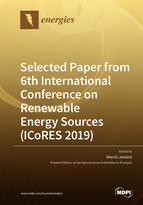Selected paper from 6th International Conference on Renewable Energy Sources (ICoRES 2019)
A special issue of Energies (ISSN 1996-1073). This special issue belongs to the section "L: Energy Sources".
Deadline for manuscript submissions: closed (31 January 2020) | Viewed by 46678
Special Issue Editor
Interests: biomass; torrefaction; pellets; agriculture biowaste
Special Issues, Collections and Topics in MDPI journals
Special Issue Information
Dear Colleagues,
The 6th edition of the Renewable Energy Sources International Conference (ICORES2019) will be one of the most recognisable scientific meetings connected to RES in Poland. From the very beginning, this conference has been a unique occasion for gathering Polish and international researchers’ perspectives on renewable energy sources and balancing them against governmental policy considerations. Accordingly, the conference has also offered panels to discuss best practices and solutions with local entrepreneurs and federal government bodies. The meeting attracts not only scientists but also industry representatives, as well as local and federal government personnel. We are open to new and fresh ideas concerning renewable energy, which is why so many scientists from Central and Eastern Europe visit Krynica to discuss the “Green Future” of this region.
In 2019, the conference is organized by the University of Agriculture in Krakow, in cooperation with the AGH University of Science and Technology (Krakow), State Agrarian and Engineering University in Podilya, University of Žilina, International Commission of Agricultural and Biosystems Engineering (CIGR) and Polish Society of Agricultural Engineering. Honorary auspices were made by the Ministry of Science and Higher Education Republic of Poland, the rector of the University of Agriculture in Krakow, the rector of the AGH University of Science and Technology and the rector of the State Agrarian and Engineering University in Podilya.
Dr. Marcin Jewiarz
Guest Editor
Manuscript Submission Information
Manuscripts should be submitted online at www.mdpi.com by registering and logging in to this website. Once you are registered, click here to go to the submission form. Manuscripts can be submitted until the deadline. All submissions that pass pre-check are peer-reviewed. Accepted papers will be published continuously in the journal (as soon as accepted) and will be listed together on the special issue website. Research articles, review articles as well as short communications are invited. For planned papers, a title and short abstract (about 100 words) can be sent to the Editorial Office for announcement on this website.
Submitted manuscripts should not have been published previously, nor be under consideration for publication elsewhere (except conference proceedings papers). All manuscripts are thoroughly refereed through a single-blind peer-review process. A guide for authors and other relevant information for submission of manuscripts is available on the Instructions for Authors page. Energies is an international peer-reviewed open access semimonthly journal published by MDPI.
Please visit the Instructions for Authors page before submitting a manuscript. The Article Processing Charge (APC) for publication in this open access journal is 2600 CHF (Swiss Francs). Submitted papers should be well formatted and use good English. Authors may use MDPI's English editing service prior to publication or during author revisions.
Keywords
- Solar energy
- Geothermal energy
- Biomass and biomass fuels
- Combustion, co-combustion, and CHP in RES systems
- Heat pumps
- Wind energy
- Fuel cell
- Waste and heat
- Modelling, simulation and optimization of renewable energy systems
- Advanced energy storage technologies
- Politics and economics of renewable energy sources






